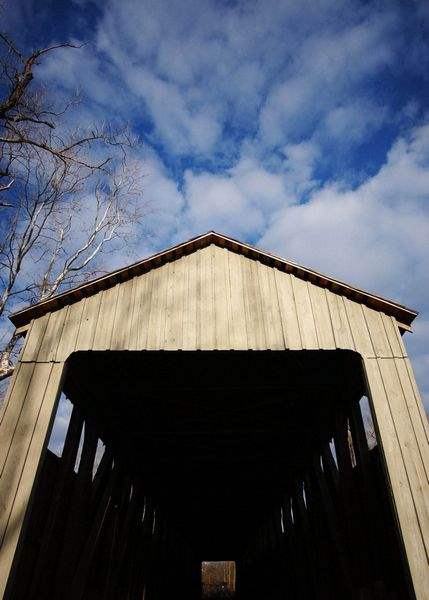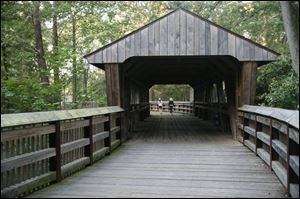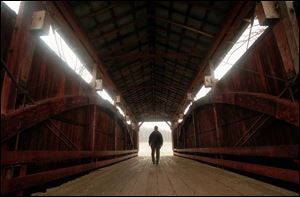
Wooden spans can connect us with the natural world
9/23/2007
Black Covered Bridge runs 206 feet over Four Mile Creek. This 1868 design on Corso Road outside Oxford, Ohio, in Butler County is closed to motor traffic.

Black Covered Bridge runs 206 feet over Four Mile Creek. This 1868 design on Corso Road outside Oxford, Ohio, in Butler County is closed to motor traffic.
We crossed the river by a wooden bridge, roofed and covered on all sides, and nearly a mile in length. It was profoundly dark; perplexed with great beams, crossing and re-crossing it at every possible angle; and through the broad chinks and crevices in the floor, the rapid river gleamed, far down below, like a legion of eyes. Charles Dickens, 1842.
Journalist, reformer, and author Dickens visited the United States and wrote this frosty account of his first covered bridge crossing. While his native England had no such structures, they have been documented around the world all the way back to 780 B.C. in Babylon.
And if, to Dickens, the crossing seemed the embodiment of a nightmare, he was definitely in the minority in the New World. His view spoke of the ever-present human resistance to change in general and perhaps some British xenophobia in particular.

Wildwood Preserve Metropark in Toledo gained this 60-foot Howe truss covered footbridge over the Ottawa River in 2002, linking original and new sections of the park.
When the first long-span bridges were built in the late 18th century, people viewed them as miraculous engineering feats, notes Smithsonian historian and curator Lola Bennett.
At the peak of their popularity in the late 19th century, there were 10,000 covered bridges in the United States.
Today there are less than 800 in 29 states. Pennsylvania has the most covered bridges. Ohio is second, followed by Indiana, where Parke County alone has 32 historic spans. And of course, there s Madison County in Iowa, with its humble but attractive flat-roofed bridges.

John Bright Bridge No. 2 is a 75-foot inverted bowstring and arch bridge built in 1881. It now crosses Fetters Run on the campus of Ohio University s Lancaster branch.
Covered bridges stand today as a delightful anomaly of 21st century transportation, not to mention as a compelling foil to contemporary life in general.
Drivers speed along complex webs of broad highways where crossing a river is accomplished in a matter of seconds. Stealing a glance through iron, steel, and concrete barriers at the waterway beneath is risky at best unless yet another element of contemporary driving is present: a traffic jam, redolent with road rage.
In an Internet world where personal development has been co-opted by the instant celebrity of YouTube and the blogosphere; where sensory stimulation is increasingly a matter of electronic synthesis, and where true intimacy has been replaced by trumpedup My Space encounters, how can we even realize what we ve traded away as we desperately try to outdo one another?
Certainly, traversing a covered bridge is no cure for the symptoms of our greedy neediness.
Yet the simple act of seeking out one of these historic treasures and experiencing it in person can help us reconnect with a past that is slipping away and, more importantly, with parts of ourselves languishing amidst contemporary clamor.
Crossing on foot is a must. Historic or new structure makes little difference. It s the deliberate step-by-step approach which allows for subtle sensory experience.
Drawing near the crossing, one meets the ripple or rush of water far beneath. Through the dark void of the bridge interior shines the promised daylight at the far side. Under the roof is shelter from the elements and respite from outside noise.
Now one hears only one s own footsteps, perhaps the inand- out of breath. The irresistible temptation to sing a note or call out the better to catch a faint echo turns men and women into children for a brief, playful moment. A stranger encountered in the sheltering space becomes a passing cohort.
Eyes meet, heads nod, greetings are exchanged. We are together, here and now. Hello and good-day.
Contact Sally Vallongo at:
svallongo@theblade.com
or 419-724-6101.